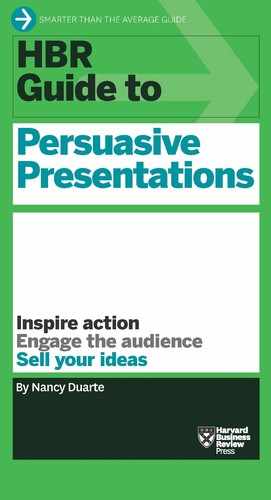Persuade Beyond the Stage
Your presentation doesn’t start the moment you enter the room; it starts the moment you’ve committed to speak—and it continues after the actual talk, as you follow up with the audience. If you take advantage of opportunities to reinforce your message at all three stages, you’re much more likely to change people’s thinking and behavior.
Before
How you position the talk before you even deliver it will have a big impact on the audience’s level of interest. Consider the most effective forms of communication to send out in advance. If you’re presenting to colleagues, you might e-mail them a summary of your message and a rough list of points you plan to cover, for example, or send a meeting request with a detailed agenda. If you’re going to speak to people from outside your organization—conference attendees, for instance—you may post your biography and talking points online and provide links to prereading material (published articles, abstracts of white papers, and so on).
Preparing strong supporting material may take as long as developing the presentation itself. However you choose to orient your audience members, make it clear how they will benefit from this talk.
During
If you need to distribute handouts during your talk, bring more than enough copies and recruit volunteers to pass them out at the right time. You can also tape secret messages under people’s chairs for retrieval at a key moment during your talk, have audience members hold up color-coded cards to give you feedback in real time, or give them all a prop to interact with, such as a product prototype.
And if you’re trying to create external buzz—about a launch, for example—post your slides online along with any videos or photos that support your presentation. Downloadable assets like these will make it easier for journalists, bloggers, and fans in social media circles to write about your talk. If appropriate, use webinar or streaming technology to further increase your audience reach.
After
Follow up with a thank-you note, a survey, or supplementary reading or viewing material to keep your message fresh in people’s minds. But don’t overtly solicit your audience. People should feel they’re getting additional insights and value—not doing extra work that benefits you more than it does them. For example, if you send a survey to find out what they think about a new service you’re offering, make it worth their time: Explain how their feedback will lead to benefits they’ll care about, and offer a relevant, attractive free product in exchange for their participation. When I wrap up a webinar on presentations, I set up a URL where the audience can access free digital content from my books on the topic. Attendees love getting free, useful tools like this. More than a quarter of them download the files.
By adding points of contact before, during, and after your presentation, you’ll make a lasting impression and increase the likelihood that your ideas will gain traction.
